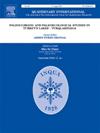Paleoproductivity development during the last 350 ka in the Guaymas Basin, central of the gulf of California
IF 1.8
3区 地球科学
Q3 GEOGRAPHY, PHYSICAL
引用次数: 0
Abstract
The biogenic silica content in the Guaymas Basin over the past ∼350 kyr exhibits a strong correlation with high XRF-based Si/Al ratios and low NGR total counts, utilizing biogenic silica as a proxy for paleoproductivity to infer past changes in the environmental conditions and productivity of the Gulf of California (GOC). Elevated bSiacc and bulkacc values, alongside fluctuations in %bSi content, were observed in the Guaymas Basin prior to the onset of MIS 6, suggesting an increased contribution of terrestrial input and enhanced stratification of surface and subsurface waters in the GOC during these periods. High %bSi values observed around ∼170 and 150 kyr during MIS 6 and the Last Glacial Maximum (LGM) indicate a strengthening of the winter monsoon in the GOC, which in turn promoted upwelling and productivity. The decline in %bSi content and XRF-based Si/Al ratios during the abrupt cold events of MIS 3 and MIS 2 suggests a reduction in upwelling intensity, likely driven by a shift in the position of the Intertropical Convergence Zone (ITCZ) and the North Pacific High (NPH), in response to the continued expansion of the Laurentide Ice Sheet until ∼16.5 kyr. This was also accompanied by reduced nutrient availability in subsurface waters due to a weakening of thermocline circulation. The elevated %bSi content during the Holocene reflects modern oceanographic conditions in the GOC, characterized by La Niña-like conditions that enhance upwelling and foster higher productivity in the central GOC during these intervals.
加利福尼亚湾中部瓜伊马斯盆地近350 ka的古生产力发育
Guaymas盆地过去~ 350 kyr的生物成因硅含量与基于xrf的高Si/Al比值和低NGR总量具有很强的相关性,利用生物成因硅作为古生产力的代表来推断加利福尼亚湾(GOC)过去环境条件和生产力的变化。在MIS 6开始之前,在Guaymas盆地观察到bSiacc和bulkacc值升高以及bSi含量%的波动,这表明在这些时期,陆地输入的贡献增加,地表和地下水在GOC中的分层增强。在MIS 6和末次盛冰期(LGM)期间,在~ 170和150 kyr附近观测到的高%bSi值表明GOC冬季季风的加强,这反过来促进了上升流和生产力。在MIS 3和MIS 2的突变冷事件期间,%bSi含量和基于xrf的Si/Al比值的下降表明上升流强度的减少,可能是由热带辐合带(ITCZ)和北太平洋高压(NPH)的位置转移所驱动的,以响应劳伦泰德冰盖的持续扩张,直到~ 16.5 kyr。这还伴随着由于温跃层环流减弱而导致地下水中营养物质的减少。全新世期间%bSi含量的升高反映了GOC的现代海洋条件,其特征是La Niña-like条件增强了GOC中部的上升流并促进了更高的生产力。
本文章由计算机程序翻译,如有差异,请以英文原文为准。
求助全文
约1分钟内获得全文
求助全文
来源期刊

Quaternary International
地学-地球科学综合
CiteScore
5.60
自引率
4.50%
发文量
336
审稿时长
3 months
期刊介绍:
Quaternary International is the official journal of the International Union for Quaternary Research. The objectives are to publish a high quality scientific journal under the auspices of the premier Quaternary association that reflects the interdisciplinary nature of INQUA and records recent advances in Quaternary science that appeal to a wide audience.
This series will encompass all the full spectrum of the physical and natural sciences that are commonly employed in solving Quaternary problems. The policy is to publish peer refereed collected research papers from symposia, workshops and meetings sponsored by INQUA. In addition, other organizations may request publication of their collected works pertaining to the Quaternary.
 求助内容:
求助内容: 应助结果提醒方式:
应助结果提醒方式:


